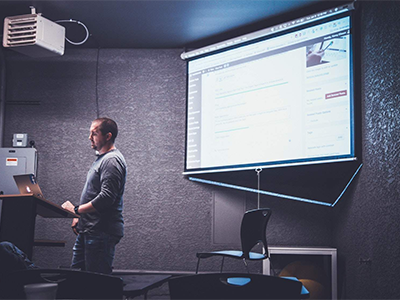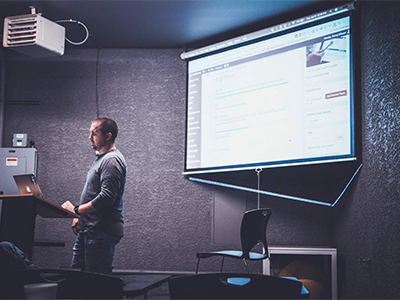 |
Effective Presentations: Question-and-Answer Session (Instructor Guide) |
0.67 |
Because audience members usually ask questions that reflect their own situation and experiences, you’ll have the opportunity to apply your topic directly to their lives, which will improve your audience’s understanding and retention of the information you present.
This Instructor's Edition of this course includes notes and suggestions to assist you in presenting the material, whether in an in-person classroom setting, or as an instructor-led online or distance-learning course. It also provides you with the answers to questions found in mid-lesson activities, as well as in the quiz that concludes the course. |
 |
CERT Unit 1: Disaster Preparedness |
1.00 |
The Community Emergency Response Team (CERT) program educates volunteers about disaster preparedness for the hazards that may occur where they live. This course covers the functions of CERT and how CERT fits into your community's emergency preparedness structure. The types of hazards that can affect communities and the hazard's potential to impact people, health, and infrastructure are discussed in this course. In addition, this course also will teach you how to face a potential disaster.
It is just one of many health and safety courses we offer. This course will help you learn the best practices for keeping yourself safe and healthy when on the job. |
 |
Falls in Construction |
1.50 |
This course is in English. We also have a version of this course in Spanish. In this course, you will watch videos on various types of falls that can occur while working in construction. You will learn about floor openings, fixed scaffolds, bridge decking, reroofing, skylights, and leading-edge work. |
 |
Caidas en la Construccion (Spanish) Falls in Construction |
1.50 |
Este curso es en español. En este curso, usted verá videos sobre varios tipos de caídas que pueden ocurrir mientras se trabaja en la construcción. Usted aprenderá sobre aberturas en el suelo, andamios fijos, entabladas de puentes, reparación de techos, claraboyas, y trabajo en cornisa. |
 |
Effective Presentations: Presentation Mechanics (Instructor Guide) |
1.00 |
For the success of your presentation, you should consider the environment. Always try to view the facility sometime during the early stages of your preparation process, because the facility itself can affect your preparation, as well as the delivery of it.
This Instructor's Edition of this course includes notes and suggestions to assist you in presenting the material, whether in an in-person classroom setting, or as an instructor-led online or distance-learning course. It also provides you with the answers to questions found in mid-lesson activities, as well as in the quiz that concludes the course. |
 |
Advanced Interpersonal Communication: Supervisors (Instructor Guide) |
0.75 |
When you think of a supervisor, you probably think of your immediate boss. However, in the workplace, most people have several supervisors. Your workplace might be divided into teams, departments or divisions. Within each level, there is a supervisor to whom you are accountable, even if you do not deal with that person on a day-to-day basis. Company executives and board members can also be considered supervisors because they might have the power to make decisions regarding your employment, salary, promotions, and work assignments. It is important to communicate effectively with all of your supervisors to maintain an efficient workplace and to be able to promote your own ideas for improvements.
In this course you will learn to: identify the types of ineffective supervisors and ways to interact with them, and negotiate a raise with a supervisor and offer an effective resignation.
This Instructor's Edition of this course includes notes and suggestions to assist you in presenting the material, whether in an in-person classroom setting or as an instructor-led online or distance-learning course. It also provides you with the answers to questions found in mid-lesson activities, as well as in the quiz that concludes the course. |
 |
Constructing: Airway Essentials—Part 6 |
0.50 |
This lesson on how to instrument the airway will give you fantastic ideas on how to create your next lab session. Take note as some pearls are offered by Dr. Christopher Galton, on how to assess and manage ALS airway procedures. Final Exam: This multiple choice exam is designed to test your knowledge of the material you just reviewed. You have two attempts to gain an 80% or higher on this exam. Please take your time and answer each question carefully. |
 |
Organizational Communication: Innovation and Change (Instructor Guide) |
1.00 |
Innovation is a new idea or process that can change the way organizations operate or think. For an idea or process to be considered an innovation, the majority of people who hear about it must consider it new. Implementation of an idea is not necessary for it to be considered an innovation.
Innovation and change are closely related. When an innovation is adopted, it becomes a change. On the other hand, not all change is innovation. If an innovation is rejected after being adopted, the return to the previous method is not an innovation.
In this course you will learn to: identify degrees and characteristics of innovation, and adopt and encourage innovation, and identify the aspects of change.
This Instructor's Edition of this course includes notes and suggestions to assist you in presenting the material, whether in an in-person classroom setting, or as an instructor-led online or distance-learning course. It also provides you with the answers to questions found in mid-lesson activities, as well as in the quiz that concludes the course. |
 |
Construction Safety & Prevention Program: CSIP Introduction |
0.25 |
CSIP Introduction is part of a twelve-part construction safety and prevention program. This course introduces construction safety standards and preventing injury on the job. This course will also cover the structure of CSIP programs and OSHA considerations and rules. |
 |
Young Worker Safety Training |
0.75 |
This course covers federal laws regarding working minors as well as common workplace hazards. |











